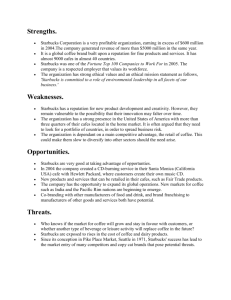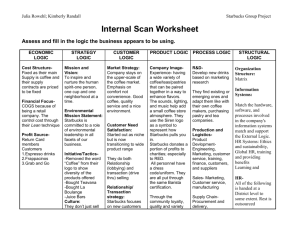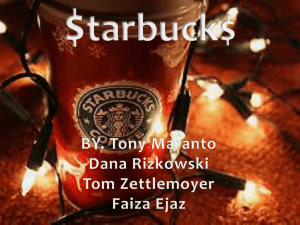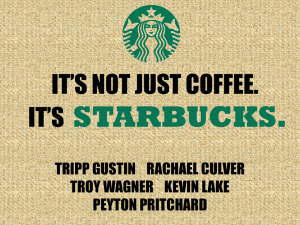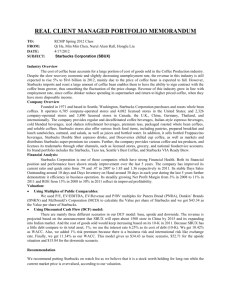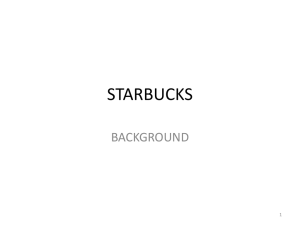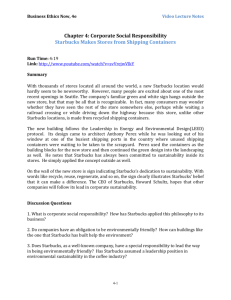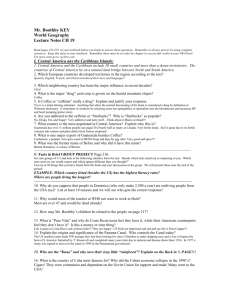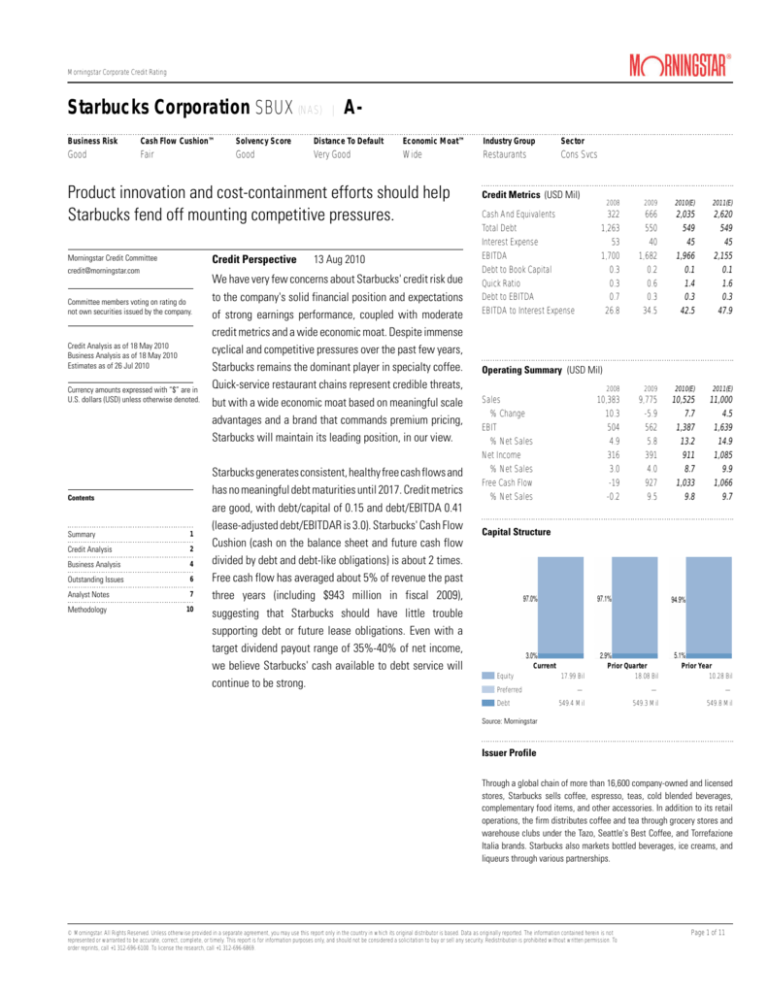
Morningstar Corporate Credit Rating
Starbucks Corporation SBUX (NAS)
|
A-
Business Risk
Cash Flow Cushion™
Solvency Score
Distance To Default
Economic Moat™
Industry Group
Sector
Good
Fair
Good
Very Good
Wide
Restaurants
Cons Svcs
Product innovation and cost-containment efforts should help
Starbucks fend off mounting competitive pressures.
Morningstar Credit Committee
Credit Perspective
credit@morningstar.com
Committee members voting on rating do
not own securities issued by the company.
Credit Analysis as of 18 May 2010
Business Analysis as of 18 May 2010
Estimates as of 26 Jul 2010
Currency amounts expressed with “$” are in
U.S. dollars (USD) unless otherwise denoted.
Contents
Summary
1
Credit Analysis
2
Business Analysis
4
Outstanding Issues
6
Analyst Notes
7
Methodology
10
13 Aug 2010
We have very few concerns about Starbucks' credit risk due
to the company's solid financial position and expectations
of strong earnings performance, coupled with moderate
credit metrics and a wide economic moat. Despite immense
cyclical and competitive pressures over the past few years,
Starbucks remains the dominant player in specialty coffee.
Quick-service restaurant chains represent credible threats,
but with a wide economic moat based on meaningful scale
advantages and a brand that commands premium pricing,
Starbucks will maintain its leading position, in our view.
Starbucks generates consistent, healthy free cash flows and
has no meaningful debt maturities until 2017. Credit metrics
are good, with debt/capital of 0.15 and debt/EBITDA 0.41
(lease-adjusted debt/EBITDAR is 3.0). Starbucks' Cash Flow
Cushion (cash on the balance sheet and future cash flow
divided by debt and debt-like obligations) is about 2 times.
Free cash flow has averaged about 5% of revenue the past
three years (including $943 million in fiscal 2009),
suggesting that Starbucks should have little trouble
supporting debt or future lease obligations. Even with a
target dividend payout range of 35%-40% of net income,
we believe Starbucks' cash available to debt service will
continue to be strong.
Credit Metrics (USD Mil)
Cash And Equivalents
Total Debt
Interest Expense
EBITDA
Debt to Book Capital
Quick Ratio
Debt to EBITDA
EBITDA to Interest Expense
2008
2009
2010(E)
2011(E)
322
1,263
53
1,700
0.3
0.3
0.7
26.8
666
550
40
1,682
0.2
0.6
0.3
34.5
2,035
549
45
1,966
0.1
1.4
0.3
42.5
2,620
549
45
2,155
0.1
1.6
0.3
47.9
Operating Summary (USD Mil)
Sales
% Change
EBIT
% Net Sales
Net Income
% Net Sales
Free Cash Flow
% Net Sales
2008
2009
2010(E)
2011(E)
10,383
10.3
504
4.9
316
3.0
-19
-0.2
9,775
-5.9
562
5.8
391
4.0
927
9.5
10,525
7.7
1,387
13.2
911
8.7
1,033
9.8
11,000
4.5
1,639
14.9
1,085
9.9
1,066
9.7
Capital Structure
Current
Equity
Preferred
Debt
17.99 Bil
Prior Quarter
18.08 Bil
Prior Year
10.28 Bil
—
—
—
549.4 Mil
549.3 Mil
549.8 Mil
Source: Morningstar
Issuer Profile
Through a global chain of more than 16,600 company-owned and licensed
stores, Starbucks sells coffee, espresso, teas, cold blended beverages,
complementary food items, and other accessories. In addition to its retail
operations, the firm distributes coffee and tea through grocery stores and
warehouse clubs under the Tazo, Seattle's Best Coffee, and Torrefazione
Italia brands. Starbucks also markets bottled beverages, ice creams, and
liqueurs through various partnerships.
© Morningstar. All Rights Reserved. Unless otherwise provided in a separate agreement, you may use this report only in the country in which its original distributor is based. Data as originally reported. The information contained herein is not
represented or warranted to be accurate, correct, complete, or timely. This report is for information purposes only, and should not be considered a solicitation to buy or sell any security. Redistribution is prohibited without written permission. To
order reprints, call +1 312-696-6100. To license the research, call +1 312-696-6869.
Page 1 of 11
Morningstar Corporate Credit Rating
Starbucks Corporation SBUX (NAS)
|
A-
Business Risk
Cash Flow Cushion™
Solvency Score
Distance To Default
Economic Moat™
Industry Group
Sector
Good
Fair
Good
Very Good
Wide
Restaurants
Cons Svcs
Credit Analysis
Five Year Adjusted Cash Flow Forecast (USD Mil)
Financial Health
2010(E)
2011(E)
2012(E)
2013(E)
2014(E)
Cash and Equivalents (beginning of period)
Adjusted Free Cash Flow
Total Cash Available before Debt Service
666
1,678
2,344
2,035
1,755
3,790
2,620
1,817
4,436
3,048
1,980
5,028
3,562
2,059
5,621
Principal Payments
Interest Payments
Other Cash Obligations and Commitments
Total Cash Obligations and Commitments
0
-45
-796
-841
0
-45
-840
-885
0
-48
-890
-938
0
-50
-928
-978
0
-53
-967
-1,019
Cumulative Annual Cash Flow Cushion
With a consistent record of positive free cash flow, no
meaningful debt maturities until 2017, and leverageable
assets on the balance sheet, Starbucks appears to be in
sound financial health. Debt/capital is 0.15 (0.67 including
operating leases), EBITDA covers interest expense by 34
times, and the Cash Flow Cushion (cash on the balance sheet
and future cash flow divided by debt and debtlike
obligations) is about 2 times. We give Starbucks an issuer
credit rating of A-.
Cash Flow Cushion
Possible Liquidity Need
Capital Structure
Adjusted Cash Flow Summary
% of
USD Millions Commitments
Beginning Cash Balance
Sum of 5-Year Adjusted Free Cash Flow
Sum of Cash and 5-Year Cash Generation
Revolver Availability
Asset Adjusted Borrowings (Repayment)
Sum of Cash, 5-Year Cash Generation, Revolver and Adjustments
Sum of 5-Year Cash Commitments
666
9,289
9,955
14.3
199.3
213.5
986
0
21.2
0.0
10,941
-4,662
234.7
—
Credit Rating Pillars Peer Group Comparison
Business Risk
Cash Flow Cushion
Solvency Score
Distance to Default
Credit Rating
SBUX
Sector
Universe
4
5
3
1
A-
4.6
6.3
5.8
4.1
BBB-
4.5
5.7
4.8
3.9
BBB+
Starbucks' capital structure is relatively straightforward and
likely to be sustained. The only long-term debt on the
balance sheet is $550 million in 6.25% senior notes due
2017, and the firm has almost $1 billion in borrowing
capacity under its revolving credit facility and commercial
paper program. Debt/capital and total debt/EBITDA have
averaged 0.28 and 0.70 during the past three years,
respectively, though we expect these metrics to remain
much closer to current levels of 0.15 and 0.41 going forward.
Free cash flow has averaged about 5% of revenue the past
three years (including $943 million in fiscal 2009),
suggesting that Starbucks should have little trouble
supporting debt or future lease obligations. In addition, the
firm had $2.5 billion in net property, plant, and equipment
as of December 2009, which should provide an asset base
to secure debt if necessary. Even with a target dividend
payout range of 35%-40% of net income, we find few
reasons to believe that Starbucks will be forced to access
capital markets on unfavorable terms over the next several
years, especially given our A- issuer credit rating for the
company.
Source: Morningstar Estimates
Note: Scoring is on a scale 1-10, 1 being Best, 10 being Worst
Enterprise Risk
Starbucks faces increased competition on several fronts,
including an influx of specialty coffee programs at
quick-service and fast-casual restaurant chains. Given its
© Morningstar. All Rights Reserved. Unless otherwise provided in a separate agreement, you may use this report only in the country in which its original distributor is based. Data as originally reported. The information contained herein is not
represented or warranted to be accurate, correct, complete, or timely. This report is for information purposes only, and should not be considered a solicitation to buy or sell any security. Redistribution is prohibited without written permission. To
order reprints, call +1 312-696-6100. To license the research, call +1 312-696-6869.
Page 2 of 11
Morningstar Corporate Credit Rating
Starbucks Corporation SBUX (NAS)
|
A-
Business Risk
Cash Flow Cushion™
Solvency Score
Distance To Default
Economic Moat™
Industry Group
Sector
Good
Fair
Good
Very Good
Wide
Restaurants
Cons Svcs
Credit Analysis
position as a more affluent consumer brand, lingering
discretionary spending headwinds could damp top-line
results. Coffee commodity costs can affect profitability, as
well as labor and occupancy cost inflation. Starbucks also
faces heightened economic, legal, and political risk
associated with its international expansion efforts.
© Morningstar. All Rights Reserved. Unless otherwise provided in a separate agreement, you may use this report only in the country in which its original distributor is based. Data as originally reported. The information contained herein is not
represented or warranted to be accurate, correct, complete, or timely. This report is for information purposes only, and should not be considered a solicitation to buy or sell any security. Redistribution is prohibited without written permission. To
order reprints, call +1 312-696-6100. To license the research, call +1 312-696-6869.
Page 3 of 11
Morningstar Corporate Credit Rating
Starbucks Corporation SBUX (NAS)
|
A-
Business Risk
Cash Flow Cushion™
Solvency Score
Distance To Default
Economic Moat™
Industry Group
Sector
Good
Fair
Good
Very Good
Wide
Restaurants
Cons Svcs
Business Analysis
Thesis
Despite immense cyclical and competitive pressures over
the past few years, Starbucks remains the dominant player
in specialty coffee. We doubt the firm can return to its lofty
historical top-line growth rates around 20%, but product
innovations, new food-service and licensing partnerships,
and international expansion should enable it to sustain a
solid, albeit more modest, long-term growth trajectory.
Quick-service restaurant chains represent credible threats,
but with a wide economic moat based on meaningful scale
advantages and a brand that commands premium pricing,
we expect Starbucks will maintain its leading position in
specialty coffee.
With more than 11,000 company-owned and licensed
locations in the U.S. representing $7.1 billion in revenue
during fiscal 2009, Starbucks maintains a sizable lead over
its direct domestic rivals, including Dunkin' Donuts, Caribou
Coffee CBOU, and Peet's Coffee PEET. The firm is often
granted exclusive leases to prominent locations rife with
consumer traffic, making it extremely difficult for these
rivals to compete effectively. Moreover, with cafelike
environments and a brand that invokes a high-quality
customer experience, Starbucks enjoys pricing power
advantages over these specialty coffee peers, in our view.
Quick-service and fast-casual restaurant chains represent
an emergent source of competition, however. McDonald's
MCD, which generated about $1.5 billion in coffee sales
through its 14,000 domestic units in 2009 and has rolled out
its McCafe program to several thousand international
locations, could develop into Starbucks' most formidable
competitor over a longer horizon. However, we believe there
is room for both firms to succeed in the large and
still-growing specialty coffee category. McDonald's has
undertaken a substantial reimaging program featuring
interior and exterior upgrades and plans to offer free
wireless Internet to its customers, but we still believe
Starbucks' upscale environments provide enough
differentiation to attract a premium audience. Moreover,
the introduction of Seattle's Best Coffee at more than 30,000
quick-service restaurant locations should allow Starbucks
to capitalize on the increasing popularity of specialty coffee
in the quick-service restaurant channel.
Although domestic opportunities are intriguing, international
markets will be the firm's primary growth vehicle. As one
of the most widely recognized brands in the world, Starbucks
is among the few retail concepts to be successfully
replicated across the globe. As such, we believe the firm
could match or even exceed its domestic store potential in
overseas markets. The chain has more than 5,500 units in
about 50 countries, including some well-established cafe
cultures such as France and Austria. Emerging market
prospects are also intriguing, including growth
opportunities in markets such as China (which already has
more than 700 units) and India.
Product innovation remains a hallmark of Starbucks'
success. A revamped food program has been additive to the
top line over the past several years, and we believe there
are opportunities to expand this program past the breakfast
and lunch dayparts. Smoothies and tea products have added
diversity to Starbucks' menu, allowing the firm to broaden
its target audience. Finally, early results from VIA,
Starbucks' entrant in the $21 billion global instant coffee
market, have been impressive. With its 37,000 current
points of distribution and significant opportunities to tap
underpenetrated overseas markets, we view VIA as a
potential multi-billion-dollar revenue stream over time.
Economic Moat
Nonexistent switching costs, intense industry competition,
and low barriers to entry make it extremely difficult for
retailers to establish an economic moat. However, we
believe Starbucks has developed a wide economic moat,
© Morningstar. All Rights Reserved. Unless otherwise provided in a separate agreement, you may use this report only in the country in which its original distributor is based. Data as originally reported. The information contained herein is not
represented or warranted to be accurate, correct, complete, or timely. This report is for information purposes only, and should not be considered a solicitation to buy or sell any security. Redistribution is prohibited without written permission. To
order reprints, call +1 312-696-6100. To license the research, call +1 312-696-6869.
Page 4 of 11
Morningstar Corporate Credit Rating
Starbucks Corporation SBUX (NAS)
|
A-
Business Risk
Cash Flow Cushion™
Solvency Score
Distance To Default
Economic Moat™
Industry Group
Sector
Good
Fair
Good
Very Good
Wide
Restaurants
Cons Svcs
Business Analysis
the result of both structural and intangible competitive
advantages. Starbucks has considerable influence over
arabica coffee bean suppliers, ensuring access to raw
materials at predictable, competitive prices. The company
is often granted exclusive lease terms for stores situated in
prominent locations rife with consumer traffic, making it
extremely difficult for competitors to develop necessary
scale advantages. With upscale cafelike environments and
one of the most widely recognized brands in the world,
Starbucks is among the few retail concepts to be
successfully replicated across the globe. As a result of these
competitive advantages, we believe the firm enjoys price
leadership advantages that allow it to generate excess
economic returns.
Moat Trend
The compelling economics behind a specialty coffee
program have attracted a number of substitutes in recent
years, most notably McDonald's McCafe menu. Though we
doubt that most quick-service restaurant chains are willing
or able to compete with Starbucks' in-store customer
experience, increased competition could erode Starbucks'
price leadership; this results in our negative moat trend
rating. That said, we believe the firm has taken prudent
steps to neutralize these competitive threats, including
partnerships to offer its Seattle's Best Coffee brand at more
than 9,000 Subway and 7,250 Burger King locations by the
end of 2010. If Starbucks is successful in its endeavors with
quick-service restaurant partnerships, we believe the moat
trend could stabilize.
© Morningstar. All Rights Reserved. Unless otherwise provided in a separate agreement, you may use this report only in the country in which its original distributor is based. Data as originally reported. The information contained herein is not
represented or warranted to be accurate, correct, complete, or timely. This report is for information purposes only, and should not be considered a solicitation to buy or sell any security. Redistribution is prohibited without written permission. To
order reprints, call +1 312-696-6100. To license the research, call +1 312-696-6869.
Page 5 of 11
Morningstar Corporate Credit Rating
Starbucks Corporation SBUX (NAS)
|
A-
Business Risk
Cash Flow Cushion™
Solvency Score
Distance To Default
Economic Moat™
Industry Group
Sector
Good
Fair
Good
Very Good
Wide
Restaurants
Cons Svcs
Outstanding Issues
Outstanding Issue By Maturity Date and Yield
Issue Information
Name
Starbucks 6.25%
Currency
USD
Maturity
Date
15 Aug 2017
Coupon
(%)
6.25
Price
114.926
Yield
(%)
3.78
Callable
Yes
Convertible
No
Modified
Duration
5.7
Source: IDC and Finra
A maximum of 33 issues is displayed.
© Morningstar. All Rights Reserved. Unless otherwise provided in a separate agreement, you may use this report only in the country in which its original distributor is based. Data as originally reported. The information contained herein is not
represented or warranted to be accurate, correct, complete, or timely. This report is for information purposes only, and should not be considered a solicitation to buy or sell any security. Redistribution is prohibited without written permission. To
order reprints, call +1 312-696-6100. To license the research, call +1 312-696-6869.
Page 6 of 11
Morningstar Corporate Credit Rating
Starbucks Corporation SBUX (NAS)
|
A-
Business Risk
Cash Flow Cushion™
Solvency Score
Distance To Default
Economic Moat™
Industry Group
Sector
Good
Fair
Good
Very Good
Wide
Restaurants
Cons Svcs
Recent Notes from our Credit and Equity Analysts
Is Starbucks’ 2011 Outlook Achievable? 22 Jul 2010
We're keeping our fair value estimate for Starbucks SBUX
intact, as the company turned in another solid quarter and
provided an initial outlook for 2011 that was consistent with
our expectations. We remain impressed by the continued
success of growth initiatives such as VIA instant coffee and
Seattle's Best Coffee and also by efforts to breathe life into
existing products. The rollout of the customizable
Frappuccino platform contributed roughly 2% of the 9% total
increase in comparable-store sales for the third quarter and
helped to drive positive sales growth of bottled Frappuccino
products sold in other retail outlets. In our view, a 6% jump
in customer traffic and increased usage of the My Starbucks
Rewards card (which has attracted more than 1 million
members in its first six months) validates our thoughts about
the relevancy of the Starbucks brand and recent in-store
enhancements. Despite lapping more difficult comparisons
versus the year-ago period and increased marketing
investments to support consumer product segment growth
platforms, Starbucks still delivered 270 basis points of
operating margin improvement to 13.3% (excluding
restructuring costs), suggesting the aggressive expense-reduction
measures and operating efficiencies put in place the past
few years can have a lasting impact on Starbucks' cost
structure. The company remains on track to meet our
full-year targets of high-single-digit top-line growth and
operating margins of around 13%.
Though early, we believe management has set realistic
expectations for 2011. Our mid-single-digit top-line growth
forecast is in line with management's, driven by
low-single-digit unit growth, mid-single-digit comparable-store
sales growth, and increased contribution from the global
consumer product group. Although tougher comparisons
and a still uncertain economic environment will probably
put 2011 comparable-store sales growth modestly below
2010 levels, we remain confident in this target as a result
of higher-ticket product platforms and other initiatives to
drive traffic. In our view, management's outlook for 50-100
basis points of operating margin expansion in 2011 (implying
midteen operating margins) appears slightly conservative,
even after taking into account higher coffee commodity
costs in the early part of the year and increased advertising
costs to support new product platforms. We remain
optimistic about Starbucks' margin expansion opportunities
in 2011 because of increased sales penetration from
profit-accretive businesses such as food service and product
licensing as well as positive leverage stemming from
cost-cutting efforts over the past few years. As such, we
would not be surprised if Starbucks came in at the high end
(or a few pennies ahead) of next year's earnings target of
$1.36-$1.41 per share.
Strong 2Q for Starbucks 22 Apr 2010
We plan to modestly raise our fair value estimate for
Starbucks SBUX after second-quarter results that reinforced
our belief that cost reductions and other operating
efficiencies put in place in the past few years will have a
lasting impact on the firm's domestic operations.
Furthermore, we have greater confidence that many of these
efforts can be replicated in international markets, driving
meaningful margin expansion over the long haul. On the
basis of the success of two of Starbucks' recent growth
initiatives--the rollout of VIA instant coffee in additional
foreign markets and new partnerships for the firm’s Seattle's
Best Coffee brand--we also plan to raise our long-term
growth assumptions for the consumer product segment.
Although we recognize the potential threat that McDonald's
MCD and other industry players represent, we continue to
believe the global specialty coffee market is large enough
to accommodate several major participants.
Given the substantial headwinds facing Starbucks during
the past two years, the firm's rapid turnaround has been
nothing short of remarkable. Comparable-store sales grew
7% for the quarter, fueled by a 3% increase in customer
© Morningstar. All Rights Reserved. Unless otherwise provided in a separate agreement, you may use this report only in the country in which its original distributor is based. Data as originally reported. The information contained herein is not
represented or warranted to be accurate, correct, complete, or timely. This report is for information purposes only, and should not be considered a solicitation to buy or sell any security. Redistribution is prohibited without written permission. To
order reprints, call +1 312-696-6100. To license the research, call +1 312-696-6869.
Page 7 of 11
Morningstar Corporate Credit Rating
Starbucks Corporation SBUX (NAS)
|
A-
Business Risk
Cash Flow Cushion™
Solvency Score
Distance To Default
Economic Moat™
Industry Group
Sector
Good
Fair
Good
Very Good
Wide
Restaurants
Cons Svcs
Recent Notes from our Credit and Equity Analysts
traffic and a 4% gain in the average ticket. We find both
components of comparable-store sales growth to be
significant; the increase in traffic for the first time in 13
quarters in the United States suggests improved consumer
discretionary spending patterns, while the average ticket
growth implies that recent pricing modifications and new
product innovations (including food offerings and VIA) are
having a meaningful impact. When combined with last
year's store closings, head count reductions, lease
renegotiations, and store-level waste-management efforts,
the strong second-quarter top-line results were enough to
drive the highest second-quarter operating margins in the
firm's history (13.4%). We believe this quarter will probably
represent the high-water mark for 2010, as the firm plans
to ramp up marketing efforts in the back half of the fiscal
year to support new in-store initiatives and the launch of
VIA in broader consumer product channels.
Starbucks Announces Initial Cash Dividend 24 Mar 2010
We are not changing our fair value estimate for Starbucks
SBUX following the announcement that the board has
authorized the firm's first-ever cash dividend. The firm will
pay its initial quarterly dividend of $0.10 per share on April
23, representing a dividend yield of about 1.6% at the
current stock price. The firm said it is initially targeting a
dividend payout ratio of 35%-40% of net income, though
future dividend payouts will be subject to board approval.
Starbucks also announced that its board has authorized the
repurchase of 15 million shares, on top of the 6.3 million
shares that remain available for repurchase under previous
programs.
Our model projects that Starbucks will generate around $1
billion in annual free cash flow the next few years, or around
9% of revenue. As such, we are confident that Starbucks
will be able to fund its growth initiatives, even with these
shareholder-enhancing activities. Since we do not expect
the firm to return to lofty double-digit revenue growth in the
foreseeable future, we believe this is the appropriate time
to put a dividend program in place.
New Credit Rating: Starbucks 09 Feb 2010
Morningstar is initiating credit coverage of Starbucks SBUX
with an issuer rating of A-. We have very few concerns about
the firm's credit risk. Starbucks carries only $550 million in
total debt obligations--equal to less than a third of operating
income, excluding depreciation and amortization--versus
about $1.4 billion in cash on its balance sheet. In addition,
the entirely of its debt load is in the form of notes that don't
mature until 2017. Operating leases are a bit more of a
concern, but we don't believe the firm will have any trouble
meeting these obligations. We forecast lease payments of
$773 million in fiscal 2010, growing to about $1 billion
annually over the next decade. Starbucks has been active
in renegotiating leases with landlords over the past year,
and our operating lease estimates may prove somewhat on
the high side. However, as there is no way to accurately
verify the impact of these lease negotiations, we prefer to
have more-stringent numbers included in our Cash Flow
Cushion calculations. Capitalizing lease expenses, we place
Starbucks' total debt load at a bit over $6 billion, bringing
leverage net of cash to 3.3 times operating income,
excluding depreciation and amortization.
While leverage in on the high side, Starbucks has a long
history of using leases wisely. Although the firm closed 800
underperforming locations in the United States because of
mounting economic challenges, stores are typically situated
in prominent locations rife with consumer traffic. In our
view, Starbucks' prime locations make it extremely difficult
for rivals to succeed. As a result of its competitive position,
the firm has generated strong, consistent free cash flows,
averaging 5% of revenue during the past five years. We
believe Starbucks is navigating the current economic
environment well and is poised to deliver modest long-term
growth in the U.S. International expansion should provide
© Morningstar. All Rights Reserved. Unless otherwise provided in a separate agreement, you may use this report only in the country in which its original distributor is based. Data as originally reported. The information contained herein is not
represented or warranted to be accurate, correct, complete, or timely. This report is for information purposes only, and should not be considered a solicitation to buy or sell any security. Redistribution is prohibited without written permission. To
order reprints, call +1 312-696-6100. To license the research, call +1 312-696-6869.
Page 8 of 11
Morningstar Corporate Credit Rating
Starbucks Corporation SBUX (NAS)
|
A-
Business Risk
Cash Flow Cushion™
Solvency Score
Distance To Default
Economic Moat™
Industry Group
Sector
Good
Fair
Good
Very Good
Wide
Restaurants
Cons Svcs
Recent Notes from our Credit and Equity Analysts
incremental growth as well. We expect the firm will
generate enough cash to cover its obligations, including
operating lease payments, 1.9 times over during the next
five years.
On the surface, our view of Starbucks could support a slightly
higher credit rating. However, 46% of the firm's 16,600
global stores were operated by licensees as of September
2009. Although we generally consider Starbucks' licensees
to be high quality, we acknowledge there are credit risks
involved with individual licensees. If Starbucks runs into a
rough patch, it has $2.5 billion in net property, plant, and
equipment that should provide an asset base to secure debt
if necessary.
© Morningstar. All Rights Reserved. Unless otherwise provided in a separate agreement, you may use this report only in the country in which its original distributor is based. Data as originally reported. The information contained herein is not
represented or warranted to be accurate, correct, complete, or timely. This report is for information purposes only, and should not be considered a solicitation to buy or sell any security. Redistribution is prohibited without written permission. To
order reprints, call +1 312-696-6100. To license the research, call +1 312-696-6869.
Page 9 of 11
Morningstar Corporate Credit Rating
Morningstar’s Approach to Rating Corporate Credit
3 Offers a proprietary
measure of the credit quality of companies on our
coverage list.
3 Encapsulates our in-depth
modeling and quantitative
work in one letter grade.
3 Allows investors to rank
companies by each of
the four underlying components of our credit
ratings, including both
analyst-driven and
quantitative measures.
Purpose
Methodology
The Morningstar Corporate Credit Rating measures the
ability of a firm to satisfy its debt and debt-like obligations.
The higher the rating, the less likely we think the company
is to default on these obligations.
We feel it’s important to perform credit analysis through
different lenses—qualitative and quantitative, as well as
fundamental and market-driven. We therefore evaluate
each company in four broad categories.
The Morningstar Corporate Credit Rating builds on the
modeling expertise of our securities research team. For
each company, we publish:
Business Risk
Business Risk captures the fundamental uncertainty around
a firm’s business operations and the cash flow generated
by those operations. Key components of the Business Risk
rating include the Morningstar Economic Moat™ Rating
and the Morningstar Uncertainty Rating.
3 Five years of detailed pro-forma financial statements
3 Annual estimates of free cash flow
3 Provides access to all
the underlying forecasts
that go into the rating,
available through our institutional service.
3 Annual forecasts of return on invested capital
3 Scenario analyses, including upside and downside cases
3 Forecasts of leverage, coverage, and liquidity ratios
for five years
3 Estimates of off balance sheet liabilities
These forecasts are key inputs into the Morningstar
Corporate Credit Rating and are available to subscribers
at select.morningstar.com.
Cash Flow Cushion ™
Morningstar’s proprietary Cash Flow Cushion™ ratio is a
fundamental indicator of a firm’s future financial health
The measure reveals how many times a company’s internal
cash generation plus total excess liquid cash will cover
its debt-like contractual commitments over the next
five years. The Cash Flow Cushion acts as a predictor of
financial distress, bringing to light potential refinancing,
operational, and liquidity risks inherent to the firm.
Morningstar Research Methodology for Determining Corporate Credit Ratings
BB
Competitive
Analysis
Cash-Flow
Forecasts
Scenario
Analysis
Quantitative
Checks
Rating
Committee
C
AAA
A
CC
Analyst conducts
company and
industry research:
Management interviews
Conference calls
Trade show visits
Competitor, supplier,
distributor, and
customer interviews
• Assign Economic
Moat™ Rating
•
•
•
•
Analyst considers
company financial
statements
and competitive
dynamics to
forecast future
free cash
flows to the firm.
Analyst derives
estimate of CashFlow Cushion™.
Analysts run bull
and bear cases
through the model
to derive alternate
estimates of
enterprise value.
Based on competitive analysis,
cash-flow forecasts, and
scenario analysis,
the analyst
assigns
Business Risk.
We gauge a firm’s
health using
quantitative tools
supported by our
own backtesting
and academic
research.
Senior personnel
review each
company to
determine the
appropriate final
credit rating.
• Review modeling
• Morningstar
Solvency Score™
• Distance to Default
assumptions
BBB
CCC
B
D
AA
AAA
AA
A
BBB
Extremely Low Default Risk
Very Low Default Risk
Low Default Risk
Moderate Default Risk
BB
B
CCC
CC
Above Average Default Risk
High Default Risk
Currently Very High Default Risk
Currently Extreme Default Risk
• Approve
company-specific
adjustments
C
D
Imminent Payment Default
Payment Default
©2010 Morningstar. All Rights Reserved. The information contained herein is not represented or warranted to be accurate, correct, complete, or timely. This report is for information purposes only, and should not be considered a solicitation to buy or sell any security.
© Morningstar. All Rights Reserved. Unless otherwise provided in a separate agreement, you may use this report only in the country in which its original distributor is based. Data as originally reported. The information contained herein is not
Redistribution is prohibited without written permission. For licensing or permission to use this information, call +1 312-696-6869.
represented or warranted to be accurate, correct, complete, or timely. This report is for information purposes only, and should not be considered a solicitation to buy or sell any security. Redistribution is prohibited without written permission. To
order reprints, call +1 312-696-6100. To license the research, call +1 312-696-6869.
of 8
PagePage
10 of7 11
Morningstar Corporate Credit Rating
Morningstar’s Approach to Rating Corporate Credit
The advantage of the Cash Flow Cushion ratio relative to
other fundamental indicators of credit health is that the
measure focuses on the future cash-generating
performance of the firm derived from Morningstar’s
proprietary discounted cash flow model. By making
standardized adjustments for certain expenses to reflect
their debt-like characteristics, we can compare future
projected free cash flows with debt-like cash commitments
coming due in any particular year. The forward-looking
nature of this metric allows us to anticipate changes in a
firm’s financial health and pinpoint periods where cash
shortfalls are likely to occur.
Morningstar Solvency Score™
The Morningstar Solvency Score™ is a quantitative score
derived from both historical and forecasted financial ratios.
It includes ratios that focus on liquidity (a company’s
ability to meet short term cash outflows), profitability
(a company’s ability to generate profit per unit of input),
capital structure (how does the company finance its
operations), and interest coverage (how much of profit is
used up by interest payments).
Overall Credit Rating
The four component ratings roll up into a single preliminary credit rating. To determine the final credit rating,
a credit committee of at least five senior research personnel reviews each preliminary rating.
We review credit ratings on a regular basis and as events
warrant. Any change in rating must be approved by the
Credit Rating Committee.
Investor Access
Morningstar Corporate Credit Ratings are available on
Morningstar.com. Our credit research, including detailed
cash-flow models that contain all of the components of the
Morningstar Corporate Credit Rating, is available to
subscribers at select.morningstar.com.
Distance to Default
The Distance to Default rating is a quantitative, marketbased measure of a company’s current financial health.
(Distance to Default serves as the basis for Morningstar’s
Financial Health Grade.) The underlying model treats
the equity of a firm as a call option on that firm’s assets.
Based on estimates of asset volatility and the BlackScholes option-pricing model, we can estimate the
likelihood that the value of the company’s assets falls
below the value of its liabilities, implying likely default.
For each of these four categories, we assign a score, which
we then translate into a descriptive rating along the scale
of Very Good / Good / Fair / Poor / Very Poor.
©2010 Morningstar. All Rights Reserved. The information contained herein is not represented or warranted to be accurate, correct, complete, or timely. This report is for information purposes only, and should not be considered a solicitation to buy or sell any security.
© Morningstar. All Rights Reserved. Unless otherwise provided in a separate agreement, you may use this report only in the country in which its original distributor is based. Data as originally reported. The information contained herein is not
Redistribution is prohibited without written permission. For licensing or permission to use this information, call +1 312-696-6869.
represented or warranted to be accurate, correct, complete, or timely. This report is for information purposes only, and should not be considered a solicitation to buy or sell any security. Redistribution is prohibited without written permission. To
order reprints, call +1 312-696-6100. To license the research, call +1 312-696-6869.
of 8
PagePage
11 of8 11

